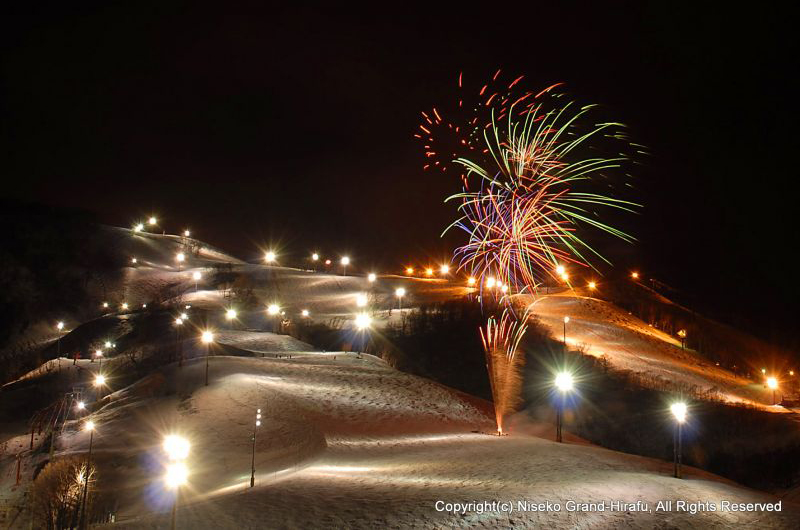December, 18th 2018

The Japanese love a good celebration, and New Year is one of the biggest. Find out a little more about the culture and tradition behind Japan’s end of year celebrations.
Christmas in Japan
Being a country with a very small Christian population, Japanese Christmas doesn’t take on the same religious connotations as in Western society, however take a trip to Japan over the Christmas period and you’ll still find many of the things traditionally associated with Christmas – festive light displays, Christmas markets, Christmas trees in shopping malls… You’ll also find a few uniquely Japanese traditions.
Gifts
Unlike the whole-family present opening sessions most Western households may be used to on Christmas Day, in Japan the gift exchange is usually just between couples and is done on Christmas Eve. Families will usually save the present-giving for New Years, which is a much bigger celebration (more on that soon!). Workplaces will often have a “Secret Santa” style gift exchange amongst co-workers, known as oseibo.
Christmas Cake
When you think Christmas cake, you probably think fruit cake or pudding, right? Well in Japan they have their own version of a Christmas cake. Although not strictly a Christmas-only treat, most stores will sell Strawberry Shortcake around Christmas time – a light sponge cake with whipped cream and strawberry filling and frosting.
Christmas lights
The Japanese love a good light display, and they sure do it well! Around Christmas time you’ll find stunning lighting displays in major shopping strips and malls as well as public parks such as Odori in Sapporo City. Otaru (about an hour from Niseko) has a great display all through December and January, and in Niseko you’ll find light displays at JR Niseko Station in Niseko Town as well as small displays throughout all the resorts of Niseko United.
New Years
New Years, known as oshogatsu is the most important holiday in Japan. It’s a time for families to get together and celebrate, and most businesses will close for a few days. If you’re in Japan around this time you’ll likely see oshogatsu decorations outsides homes and businesses – They usually feature branches of pine tree, which symbolizes longevity and good luck, and bamboo which is a symbol of good health and resilience. Some of the decorations might also feature fruit such as mikan (Japanese mandarines) or the red berries of the plant called senryo (literally “a thousand coins”), which are symbols of wealth and prosperity.
New Years Eve
This is a time for a traditional family dinner, usually osechi, which is made up of many small dishes that have important meanings for being served. Soba (buckwheat noodles) are also served and signify long life and happiness. At midnight, a visit to the shrine is often made to ring in the new year – this first visit of the new year is called hatsumode.
New Year’s Day
A popular tradition is to watch the first sunrise of the new year, known as hatsuhinode. Another significant ceremony is the kagami biraki – translated as “opening the mirror” in reference to the transition from one stage to another – which involves breaking open a sake barrel with wooden mallets and also pounding mochi (rice cakes).

You can experience some of these traditional events yourself if you’re in Niseko for Christmas or New Year. Check out our guide to events for more details.
Niseko Fan Interview: Why Do You Come Back Year After Year?
Niseko is one of those places where one visit is never enough. Many people who come once end up coming back again and again. We asked a couple fro...
29 March 2024
Niseko’s Late Spring: Ski Until May 6th, Enjoy Cherry Blossoms, and Go Rafting!
Days are getting warmer and the weather clearer in Niseko now that we are in the spring season. We have over a month left in Niseko’s ski season,...
29 March 2024
Epic Savings, Epic Skiing: Discover Niseko’s Beautiful Spring
The peak powder season has come to an end, which means that our epic spring season has begun. Niseko’s spring is not to be missed with temperatur...
27 February 2024
Can You Find These Iconic Landmarks Across Niseko United?
Spring is the perfect time to explore the four Niseko United ski resorts, and while you're at it, take plenty of Instagram-worthy scenic shots. G...
27 February 2024
Get Ready for the Ultimate Spring Ski Experience in Niseko
While Niseko is in the middle of peak winter now, its milder yet equally captivating spring season is just around the corner. Spring in Niseko...
25 January 2024
Introducing You To My Niseko Village with Ski Instructor Satoshi-Sensei
Satoshi Nakagawa, originally from Sapporo City, is a ski instructor at Niseko Village Snow School (NVSS). This is his 21st year as an instructor,...
25 January 2024
Introducing You To My Grand HIRAFU with Ski Instructor Hideaki-Sensei
Hideaki Imaizumi, originally from Iwanai Town close to Niseko, is the head of school at Niseko Tokyu Grand HIRAFU Ski School. He explains when he...
25 January 2024
Introducing You To My Hanazono with Ski Instructor Shintaro-Sensei
Shintaro Kawauchi, originally from Osaka, is a ski instructor at Niseko International Snowsports School (NISS ). This is his 18th season as an in...
29 December 2023
Introducing You To My Annupuri with Ski/Board Instructor Wataru-Sensei
Wataru Kasai, originally from Yokohama in Kanagawa Prefecture, is a ski and snowboard instructor at Niseko Annupuri Ski & Snowboard School (N...
29 December 2023
Take A Ski Break! Adventure & Luxury Off The Ski Slopes
While skiing and snowboarding is at the top of the list on Niseko's go-to winter activities, there's a whole world of unique experiences waiting ...
29 December 2023
Niseko United Dining Guide For Winter 2023-24
One of Niseko’s biggest draw cards is its dining scene – from Michelin-starred restaurants to cosy, family-owned eateries, this winter wonderland...
28 November 2023
Unmissable December Events in Niseko: Christmas Celebrations to Epic Countdowns
December is one of the most festive and exciting months to be in Niseko. It marks the beginning of winter, offers a true white Christmas, and fea...
28 November 2023
Almost One Month Until Niseko United Opens – This Is What To Expect
The countdown has begun! There’s only about one month remaining until Niseko’s ski resorts open their doors for another epic snowy season. For...
30 October 2023
We’ve Seen The First Snow in Niseko For Winter 2023/24
Mt Annupuri, Photo: Glen Claydon Photography Anticipation for the coming winter is building with the first snow falling at village level in l...
30 October 2023
4 Tips for First-timers Visiting Niseko This Winter
Thinking of visiting Niseko for the first time this winter? Here are four tips to keep in mind as you prepare for your exciting trip. 1. R...
5 October 2023
8 Places and Times to View Autumn Foliage around Niseko
Right before the snowy season, Niseko goes through a short but marvelous autumn foliage season. From mountains to ponds, there are countless pict...
5 October 2023
SUBSCRIBE TO OUR NEWSLETTER






Copyright © 2019 Niseko United.日本語